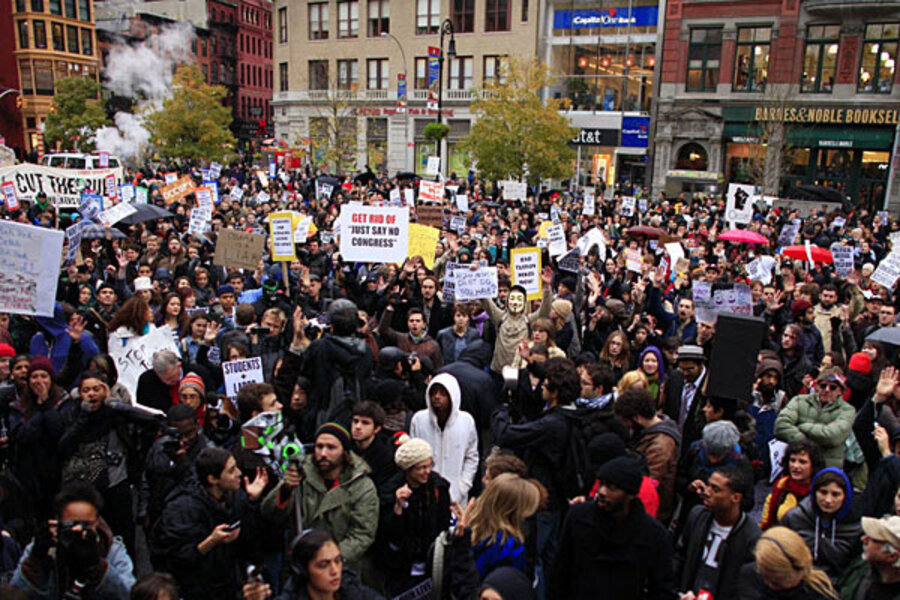Occupy Wall Street at two months: Hundreds arrested across US
Loading...
| New York
Thousands of Occupy protesters took to the streets of cities across the United States Thursday, and hundreds were arrested after scuffles with police.
The national "day of action" marked two months since the creation of the movement and took place two days after New York City police evicted Occupy Wall Street from its longtime Manhattan base, a tent compound in Zuccotti Park.
More than half the day’s arrests were made in New York where, after failing to delay trading on the New York Stock Exchange in the morning and demonstrating throughout the damp day, a swelling crowd of thousands of Occupy Wall Street sympathizers marched on a cold windy evening to the Brooklyn Bridge.
Bridges were targeted in other US cities as well, including Boston, Detroit, and Miami, Reuters reported, with protesters issuing a specific demand from the government that is a rarity for Occupy movement events: increased infrastructure spending to create jobs. Other cities that saw significant protests included Los Angeles, Washington, Las Vegas, and Portland, Ore.
In New York, following the morning clashes around Wall Street that featured some violence and most of the day’s arrests, the afternoon saw more of a traditional rally, in which students were using their imagination to try to communicate.
In Union Square, which is relatively close to several universities, five women from New York University held long thin mirrors with statements on them such as “I am you,” reflecting their belief they represent 99 percent of Americans.
A student wearing a mask held up a sign: “Arrest one of us; two more appear. You can’t arrest an idea.” And, students chanted in unison, “Shut the city down.”
Police in the afternoon maintained a relatively low-key presence compared with the morning, when they pushed and shoved protesters off the streets. At an afternoon press conference held before the march on the Brooklyn Bridge, Police Commissioner Ray Kelly said 177 people had been arrested at that point, mostly for resisting arrest and disorderly conduct.
Mr. Kelly said seven police officers had been injured, five of them hurt when an unidentified liquid was thrown in their faces. Another officer was hurt and taken to the hospital after using his hand to block a glass object that was thrown at him.
“Make no mistake about it, if anyone’s actions cross the line ... we will respond accordingly,” Mayor Michael Bloomberg said at a press conference at the hospital where the police officer was taken. He said protesters had “deliberately pursued violence.”
At Union Square, many of the protesters seemed far more interested in getting across their message than fighting with the police. As drums resonated in the background, students held a “People’s Assembly,” including their famed “People’s Microphone,” where one person says something and everyone else repeats it.
“We say power,” said one speaker, followed by: “Now can you hear?”
As he handed out posters decrying student debt, Anthony Zirpoli, a graduate student at the New School, said he hoped something could be done so students don’t leave school owing tens of thousands of dollars. “I am hoping this turns into a group that actually affects things,” said Mr. Zirpoli who has over $120,000 in student loans.
Also, in the crowd were some long-time left-leaning observers. One of those, Michael Ratner, president of the Center for Constitutional Rights, said he had been waiting 40 years, since the 1960s, for people to take to the streets.
He thinks the Occupy group has a broader base than the demonstrations he participated in during the Vietnam War. “This is about economic and power disparities,” he said. “This has a broader base to it.”
Another observer from the ‘60s era, Gregg Lundahl, a New York City teacher, says he came to march with the group since he views it as an effort to restore democracy. “We’re living in a plutocracy right now,” he says.
One of Mr. Lundahl’s issues: raising taxes on Wall Street. “People should be paying their fair share of taxes,” he says.
As the rally continued, some union workers joined. One of those was Seth Goldstein, a business representative for Local 153, which represents clerical and office workers in the tri-state region. “This is our future,” he says, pointing to the students. “We are 150 percent with this group.”
Mr. Ratner says he thinks it’s unlikely the Occupy movement will fade with the winter. “My guess is that by the spring we’ll see ‘occupations’ at every university in the country.”





